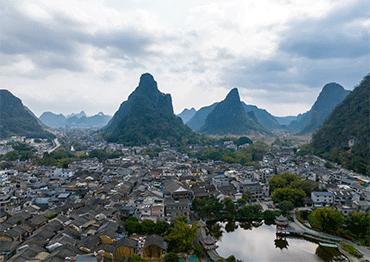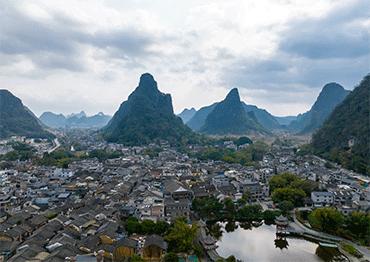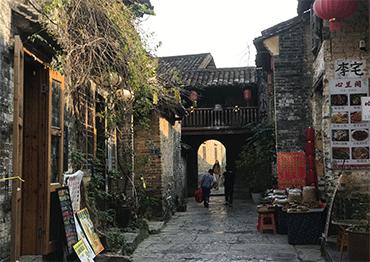Huangyao might not be as famous as its glitzy neighbor Guilin, but its ancient culture, historic clan architecture and natural surroundings provide an alternative for a trip to Guangxi Zhuang Autonomous Region. Huangyao is administered by the prefecturelevel city of Hezhou, the nearest transport hub, and is divided between the old and new town areas. While the new town offers modern shops, hotels and other conveniences, it is the historic old town that will capture your attention.
In many “ancient” towns in China, a majority of the local buildings are actually from the Qing Dynasty (1644-1911). Not so in Huangyao, with a history extending at least a thousand years to the Song Dynasty (960-1279). According to local legend, the name Huangyao was first recorded during the reign of Emperor Renzong (1022-1063) and represented the area’s two most common family names, Huang and Yao.
There are two primary factors that make Huangyao an attractive destination. The first is to do with scale. While there is no shortage of historic towns in China, many are either very small, have been swallowed within major cities, or have been altered extensively over recent decades. Huangyao is different. Huangyao boasts hundreds of buildings from the Qing and the preceding Ming Dynasty (1368-1644) and is home to thousands of people. The narrow streets, largely free from traffic, display an authenticity that is rare and refreshing. The picturesque nature of Huangyao’s streets help to explain why the town has become popular with film and television producers, being used as a backdrop to the 2006 film The Painted Veil and the 2001 television drama Country Spirit.
The second factor is its natural setting. The town is built on the meeting point of three rivers, the Yao River, the Xiaozhujiang River and the Xingning River. In some areas these rivers rush through the town with rapid force, while in other locations the rivers widen and calm, producing areas similar to lakes adorned with small river islands. Naturally, the town is crisscrossed with attractive historic bridges, and many bars and restaurants line the banks of the rivers offering stunning views. These views are complimented perfectly by the nine majestic karst mountains that surround Huangyao. In some places the karst peaks are so close that the town appears to nestle comfortably into the very base of the mountains, as if sheltering for protection. Between the jagged peaks, the gushing water, the creaking of spinning water wheels, the regal bridges, the territorial cries of swans, and the aromas of Guangxi street-food, Huangyao offers a magnificent feast for every sense.
As well as enjoying the fascinating views of the town, tourists can visit a large variety of temples, pavilions and ancestral halls. The ancestral halls are particularly interesting for international visitors as they offer a rather unique perspective into east Asian culture. Ancestral halls are essentially temples, spiritual homes and eternal resting places for people of the same clan and family name. So in the Wu family ancestral hall, in the center of Huangyao, people with the family name Wu come from far and wide to remember their ancestors, offer gifts to them, pray and mourn. In this regard, they function somewhat like family mausoleums in the West. However, unlike Western family mausoleums, which typically honor only a handful of direct relatives, these ancestral halls honor a lineage that stretches back into eternity, to the legendary founders of each family. As such, ancestral halls may be places of pilgrimage for thousands, if not hundreds of thousands, of people who are only very loosely related.
In addition to the temples, pavilions, and ancestral halls, there are small museums that visitors can enter, including some small houses where famous people either lived or were born. Without prior knowledge of the famous people, it is sometimes difficult for international visitors to grasp the importance of these houses. Nevertheless, it can still be fascinating to see how houses were historically decorated and internally organized.
Some of the most important sites include the Immortal Ancient Well, Wu Family Ancestral Hall, An’le Temple, the Ancient Opera Stage, the Watch Tower, Sima Mansion and the 500-year-old Banyan tree.
Huangyao has a lively cultural scene, with many bars and restaurants boasting live music in the evenings. Moreover, at 8 pm on Thursdays, Fridays and Saturdays there is an hour-long historical drama, called Linhe Changge performed at the Huangyao Theater beside the Wu Ancestral Hall. The play follows the story of General Zhong Shixiong and his fight for national unity, which has strong links to the local area.
The town’s rich cultural identity extends to its provision of interesting hotels, guesthouses, coffee shops, restaurants, cafes and craft shops. While you can buy generic, low-quality souvenirs in the town, high-quality individual craft items are refreshingly dominant throughout Huangyao. This is evident in everything from the small non-chain coffee outlets to ceramics specialists, tea pot purveyors, makers of homemade ice-creams and metalworkers. Likewise, the small guesthouses within the old town offer infinitely more character and charm than the larger hotels in the new town area, which attract larger groups of tourists.
Of course, no trip to Guangxi is complete without an exploration of the local cuisine. Thankfully for vegetarians and vegans, Huangyao has two specific local specialties, Huangyao tofu and Huangyao fermented black beans. It is said that every citizen of Huangyao has their own recipe for making these tofu and black bean dishes. However, non-meat eaters do need to be careful, as it is common locally to mix the special local tofu with pork. Beyond Huangyao’s unique specialties, the city offers good access to many additional favorites from across Guangxi, including Guilin rice noodles. These noodles are often served with meat, gravy, Chinese herbs, egg and tofu. Other famous dishes include beer fish, sticky rice cooked in bamboo tubes, duck stewed in gingko nut soup and dried fish with pickled vegetables. But the most famous dish from the region is river snail noodles, a dish with a famously strong flavor and odor due in large part to the primary ingredient. In addition to these gastropods, the dish typically includes pickled bamboo shoots, peanuts, sour radish, black fungus, string beans and crispy tofu skin.
The people of Huangyao celebrate local festivals that are unique to the area. These can prove popular with visitors, and therefore the town can get rather busy on these days. On the second day of the Chinese lunar calendar the people of Huangyao gather to practice dragon dancing, fish dancing, lion dancing and play the suona horn. On the 14th and 15th nights of the 7th month of the Chinese lunar calendar, people gather on riverbanks in the town to place lamps made from pomelos into the river. This is known as the Hungry Ghost Festival. After the lamps have been placed into the river, young people jump into the river to gather the lamps and share the pomelos with their family.

 Old Version
Old Version

